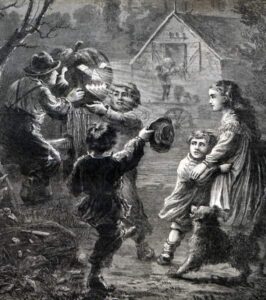 This autumn holiday may have begun as a simple Pagan festival in which food for spirits was left on doorsteps, but today it has become an extravaganza of spooks. In the eighth century, Pope Gregory III declared November 1st “All Saints Day,” making October 31st “All Hallow’s Eve.” When the tradition arrived in America, only Maryland and the southern colonies participated. The Irish influx into the states spurred the popularity of Halloween. By 1850, Americans across the country were dressing up and knocking on doors in hopes of receiving food or money. Today we call this “Trick-or-Treat.”
This autumn holiday may have begun as a simple Pagan festival in which food for spirits was left on doorsteps, but today it has become an extravaganza of spooks. In the eighth century, Pope Gregory III declared November 1st “All Saints Day,” making October 31st “All Hallow’s Eve.” When the tradition arrived in America, only Maryland and the southern colonies participated. The Irish influx into the states spurred the popularity of Halloween. By 1850, Americans across the country were dressing up and knocking on doors in hopes of receiving food or money. Today we call this “Trick-or-Treat.”Though not like it is today, Halloween was in fact celebrated during the Civil War. If you look hard enough, you can find references to Halloween in the media. For example, Harper’s Weekly published the political cartoon “Jefferson Davis Reaping the Harvest” in October 1861. The ghoulish scene depicted the Confederate President gathering wheat topped with skulls. In October 1863, Harper’s Weekly published a cartoon showing Copperhead Clement Vallandigham as a pumpkin. In November of 1864, Abraham Lincoln was depicted in a cartoon as a vampire.
Another reference to Halloween can be found in The Peoria Morning Mail which included the following in its Nov. 2, 1862 issue: “All-Hollow E’en.”—This old-time anniversary which took place on Friday evening was made the excuse by some of our wild boys for throwing unsavory missiles, putrid vegetables; taking gates off of the hinges, and sundry other pranks. This was probably “good fun” to the boys, but for those thus attacked it was not so desirable. This is the way a “very quiet” night was spent as stated by a contemporary.’
In November 1864, Kate Stone wrote the following in her journal Brokenburn: “Some gentlemen called, and we had cards. After they left, Lucy and I tried our fortunes in diverse ways as it was ‘All Hallow’e’en.’ We tried all magic arts and had a merry frolic, but no future lord and master came to turn our wet garments hanging before the fire,” she wrote. On Halloween if one was to wet the sleeve of a shirt and hang it to dry in front a fire while lying in bed and watching it till midnight. Supposedly, “the exact apparition of the anxious inquirer’s future partner for life [would] come in and turn the sleeve, as if to dry the other side of it.”- London Evening Standard, “Halloween,” 31 October 1878, p. 2. “There were no ghostly footprints in the meal sprinkled behind the door. No bearded face looked over our shoulders as we ate the apples before the glass. No knightly forms of soldiers’ brave disturbed our dreams after eating the white of an egg half-filled with salt,” Kate continued.
the fire,” she wrote. On Halloween if one was to wet the sleeve of a shirt and hang it to dry in front a fire while lying in bed and watching it till midnight. Supposedly, “the exact apparition of the anxious inquirer’s future partner for life [would] come in and turn the sleeve, as if to dry the other side of it.”- London Evening Standard, “Halloween,” 31 October 1878, p. 2. “There were no ghostly footprints in the meal sprinkled behind the door. No bearded face looked over our shoulders as we ate the apples before the glass. No knightly forms of soldiers’ brave disturbed our dreams after eating the white of an egg half-filled with salt,” Kate continued.
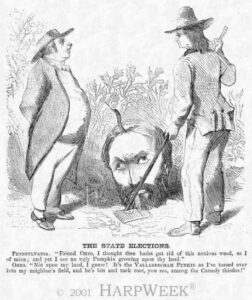 the fire,” she wrote. On Halloween if one was to wet the sleeve of a shirt and hang it to dry in front a fire while lying in bed and watching it till midnight. Supposedly, “the exact apparition of the anxious inquirer’s future partner for life [would] come in and turn the sleeve, as if to dry the other side of it.”- London Evening Standard, “Halloween,” 31 October 1878, p. 2. “There were no ghostly footprints in the meal sprinkled behind the door. No bearded face looked over our shoulders as we ate the apples before the glass. No knightly forms of soldiers’ brave disturbed our dreams after eating the white of an egg half-filled with salt,” Kate continued.
the fire,” she wrote. On Halloween if one was to wet the sleeve of a shirt and hang it to dry in front a fire while lying in bed and watching it till midnight. Supposedly, “the exact apparition of the anxious inquirer’s future partner for life [would] come in and turn the sleeve, as if to dry the other side of it.”- London Evening Standard, “Halloween,” 31 October 1878, p. 2. “There were no ghostly footprints in the meal sprinkled behind the door. No bearded face looked over our shoulders as we ate the apples before the glass. No knightly forms of soldiers’ brave disturbed our dreams after eating the white of an egg half-filled with salt,” Kate continued.The love-stricken one has to take a candle and go alone to a looking-glass … when there she has to eat an apple before it and comb her hair. If lucky, she will see the face of her future husband pepping over her shoulder.”Alnwick Mercury, “The Observances of Hallowe’en,” November 4, 1882, p. 2. Obviously, according to Kate, this superstitious practice was done earlier in 1864. ***If a girl boils and egg and then removes the yolk, filling the empty space with salt. At bedtime, she eats the salted egg, and then she will dream about a man bringing her a pail of water to quench her thirst. This is the man she will marry. It’s interesting to think about how traditions have changed over the years. Even with the special effects, we have today, it’s important to remember that no horror movie can compare to what American soldiers experienced during the Civil War.
Image 1: A family tries out their Jack-o-Lantern. “The Pumpkin Effigy,” – Drawn by L.W. Atwater. Harper’s Weekly Magazine, November 23, 1867, p. 737
Image 2: President Abraham Lincoln was portrayed as a vampire threatening Columbia (a symbol of America) in this cartoon from November 1864. The caption was “Columbia, thou art mine; with thy blood I will renew my lease of life — ah! ah!” which makes Lincoln sound strangely like Count Count from Sesame Street!
Image 3: Harper’s Weekly, October 1861 – Jefferson Davis Reaping the Harvest.” The ghoulish scene depicted the Confederate President gathering wheat topped with skulls.
Image 4: Harper’s Weekly, October 1863 – A cartoon showing Copperhead Clement Vallandigham as a pumpkin.

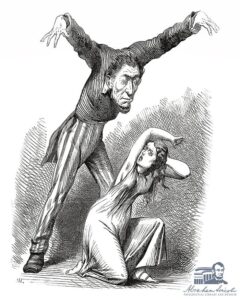
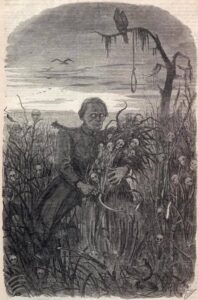
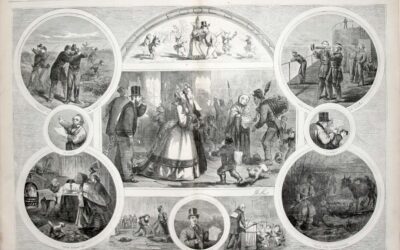
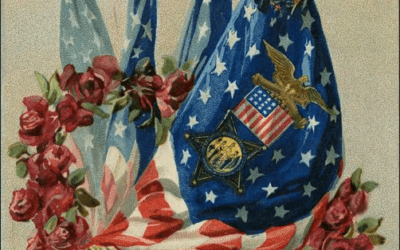
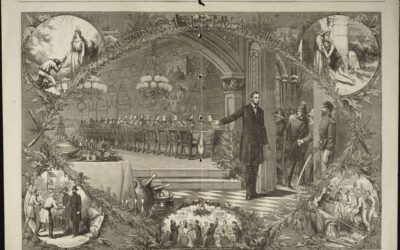
0 Comments